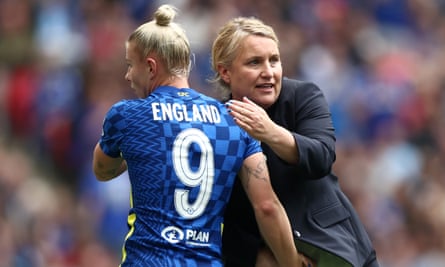Until very recently female footballers rarely talked about periods in public. Most fans were unaware that some leading internationals detested playing in white shorts during menstruation.
“I’ve experienced it as an England player and you just sort of got on with it,” said the former Lionesses defender Anita Assante, who retired from playing last spring and is now Bristol City’s first-team coach. “It wasn’t something that was discussed and it wasn’t something you felt you could change.”
Things finally began to alter last summer when, with England newly crowned as European champions, the team’s kit manufacturer, Nike, acted on players’ concerns about potential leakage. As the Arsenal striker Beth Mead, the Lionesses’ spokeswoman on the issue, put it: “An all-white kit isn’t practical when it’s that time of the month.”
On Thursday night Sarina Wiegman’s side duly unveiled their new blue shorts as they beat Brazil on penalties at Wembley. With the WSL club Manchester City among the domestic teams to have also ditched white and New Zealand announcing they are following suit before this summer’s World Cup, it is becoming quite a trend.
It all leaves the Republic of Ireland as something of an outlier as Vera Pauw’s squad prepare for Australia and New Zealand 2023 but senior players decided to stick with tradition and declined to demand that their kit maker, Castore, initiate a change. “With a supply of protective underwear the players felt staying with white shorts was the preferred option,” said the Football Association of Ireland.
Wales have also scheduled talks regarding a possible switch to coloured shorts but their captain, Sophie Ingle, is unsure as to the likely outcome. “I don’t know how everyone will feel about it,” the Chelsea player said. “It’s a very individual thing.”
Perhaps the most significant factor is that leading coaches, male and female, are finally addressing the physiological effects of the menstrual cycle. After all, its impact on footballers extends far beyond periods and their potential for creating unwanted blood stains.
Arguably the biggest issue is the ovulatory cycle’s relationship with the volume of serious knee injuries, or more specifically anterior cruciate ligament tears and cartilage-destroying osteochondral defects, sustained by female players. Periods may be uncomfortable, downright painful and, for some, embarrassing, but a ruptured ACL can destroy careers and livelihoods.
“Female athletes are up to six times more likely to have a non-contact ACL injury than their male counterparts,” says the leading sports scientist Dr Emma Ross, formerly head of physiology at the English Institute of Sport and co-founder of The Well HQ. “When oestrogen is elevated in the menstrual cycle, in about the second week, it can create looser, more lax, less stable joints, more inclined to injury.”
While wider medical research into the link between ACL injuries and the menstrual cycle continues, backroom staff working with, among other international sides, England and the United States now pay particular attention to the day-to-day management of players’ periods.
Similarly an increasing number of clubs follow the example of Chelsea and track players’ cycles. Emma Hayes, Chelsea’s manager, was at the vanguard of this trend when, in 2020, she revealed her club were working with Dr Georgie Bruinvels, the creator of the FitrWoman menstrual cycle monitor for the sports science company Orreco.
after newsletter promotion
“The menstrual cycle is an inflammatory process and excess inflammation can result in injury,” said Bruinvels, explaining that tracking the cycle enables coaches to know when to minimise the likelihood of bone damage and soft tissue injuries by reducing a player’s workload and nutritionists to understand how best to tailor an individual’s diet.
Last November the striker Bethany England, then with Chelsea but now at Tottenham, told the Guardian how Hayes’s foresight in employing Bruinvels had transformed her life. “Understanding my cycle’s impact on my body is huge,” she said. “Knowing when it’s at its strongest and weakest helps with training load and intensity. And I know which foods lower my pain.”

Although club medics can supply powerful painkillers to ease period cramps, some players circumvent the problem entirely by using the contraceptive pill in a way that means they either do not menstruate or have lighter, more manageable, periods.
Some research indicates that the pill may help guard against ACL ruptures but not every player wants to take artificial hormones and the attendant risk of blood clots mean some are unsuited to them. In 2018 the Germany and Lyon midfielder Dzsenifer Marozsan collapsed with a pulmonary embolism caused by oral contraception.
Mercifully such cases are extremely rare but the sight of women’s teams wearing white shorts remains surprisingly common. As Ireland have demonstrated there is no consensus on the issue but at least leading figures within the game are finally starting to talk about a subject that was once almost taboo.

